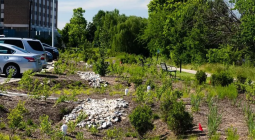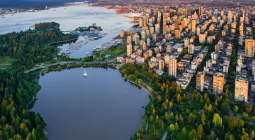Urban green spaces have vital role in cutting heat-related deaths, study finds
Comprehensive review suggests that adding more parks, trees and greenery could improve public health
Green spaces in cities play a vital role in reducing illness and deaths caused by climate breakdown, according to the most comprehensive study of its kind.
The findings of the review suggest that adding more parks, trees and greenery to urban areas could help countries tackle heat-related harms and improve public health.
The record for the world’s hottest day tumbled twice in one week earlier this year when the global average surface air temperature reached 17.15C (62.87F) breaking the record of 17.09C set days earlier.
The climate crisis is driving up global temperatures as greenhouse gas emissions released when humans burn fossil fuels warm the Earth’s atmosphere.
The overall beneficial effects of green spaces is well established, but until now their effects on heat-related health risks were poorly understood.
Now a review of the evidence led by the London School of Hygiene & Tropical Medicine suggests that abundant green space in urban areas is linked to lower rates of heat-related illness and deaths, as well as better mental health and wellbeing.
“Urban green spaces play a vital role in mitigating heat-related health risks, offering a potential strategy for urban planning to address climate change and enhance public health,” the researchers wrote in the journal BMJ Open.
“A review of urban greenery and its effect on heat-related morbidity and mortality suggests that urban green spaces, such as parks and trees, can have a positive impact on reducing the negative health effects associated with high temperatures,” they added.
“Studies have found that areas with more green space have lower rates of heat-related morbidity and mortality compared with areas with less green space. Moreover, urban greenery can also have a positive impact on mental health and wellbeing, which can also contribute to reducing the negative health effects of high temperatures.”
In recognition of the harmful heat-related effects of climate breakdown, one of the UN’s sustainable development targets stipulates the provision of universal access to safe and accessible green and public spaces, especially for vulnerable groups, such as children, elderly people, and those living with long-term conditions, by 2030.
For the review, researchers looked at the effects of green zones on death and ill health in urban areas across the globe, drawing on relevant published research.
They included content published in English between January 2000 and December 2022, and reviewed 12 studies out of an initial haul of more than 3,000 from Hong Kong, Australia, Vietnam, the US, South Korea, Portugal and Japan.
These included epidemiological, modelling, and simulation studies, as well as experimental research and quantitative analyses.
The review showed that urban green spaces such as parks and trees could help offset the adverse health effects of high temperatures. Areas with more green space had lower rates of heat-related ill health and death than areas with less green space, particularly among vulnerable groups.
Access to green spaces is an example of health inequalities facing people worldwide.
A Guardian investigation revealed earlier this year that children at the top 250 private schools in England had more than 10 times as much green space as those who go to state schools.
Doctors also warned that a “truly alarming” lack of access to green space for some families was exacerbating the child obesity crisis.
Cover photo: By The Guardian






